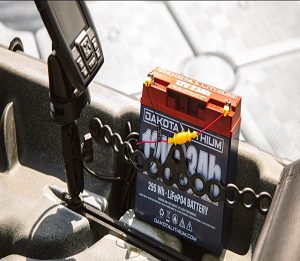 So if you are really interested in fishing, you probably might know that a fish finder is a must-have tool. Fishfinders just make it convenient and easier to identify and capture fish. Well, they need power to operate, which often comes from batteries.
So if you are really interested in fishing, you probably might know that a fish finder is a must-have tool. Fishfinders just make it convenient and easier to identify and capture fish. Well, they need power to operate, which often comes from batteries.
Fishfinders are considered important elements for having a great fishing trip and ensure that you would not be coming home empty-handed. The best thing about it is that many fish finders don’t require high-intensity currents to operate, but it is of great significance to make sure that the power supply must be reliable and constant.
When considering the larger vessels, when the main engines are not working, fish finders are turned on through the boat’s onboard battery or in some cases batteries. Whereas on smaller kayaks, boats, pontoons, or even inflatables, fish finders are usually powered via some dedicated batteries that must hold enough power for the fish finder to operate properly and smoothly during fishing.
Common terminologies used in fish finder batteries
Ampere is the amount of current passing through a circuit at a time. Ampere-hour is an actual measurement of a battery’s capacity which is calculated by multiplying the current and the discharge time. Cycle life refers to the estimated number of times a battery could be charged. Plus, discharge a battery before it loses its potency by 80%.
Voltage is something known as potential difference, it is the rate of the amount of electromotive force required to move one ampere through a wired circuit. Watts is the amount of power stored in a battery.
All you need to consider while dealing with fish finder batteries
The process of powering fishfinders, GPS, sonars and other electronics on larger fishing boats is not that complicated. Start with Plugging the devices in and only a few Amps of current will be needed to discharge the main deep cycle marine battery. This battery is usually connected to wind turbines, solar panels, and to the main engine’s alternator. Well, while dealing with small fishing boats, kayaks, pontoons, and even canoes, the situation gets a bit confusing.
Types of batteries used in fishfinder
Some of the most popular fishfinder batteries used in fishfinders are lithium deep cycle batteries and 12V AGM/Gel-cell Sealed Lead-Acid (SLA), both types have their pros and cons.
Sealed lead-acid batteries
Sealed lead-acid batteries are normally used as a deep cycle or in some cases dual purpose marine batteries. Plus, they easily function at any position only with an exception of an upside-down position. Sealed lead-acid batteries are leakproof, come in various shapes sizes. And the most important thing, they are rather cheap.
Nickel Metal Hydride
Nickel Metal Hydride (NiMH) batteries are considered to provide the same capacity as lead-acid batteries, the difference arises when it comes to weight because they come in much lower weight. Well, They cost more money and require special chargers. Plus, NiMH batteries are not commonly used as fish finder batteries due to the introduction of the technology of lithium batteries.
Lithium batteries
These batteries can be recharged much faster than lead-acid batteries and support a much larger number of charging and discharging cycles than other batteries. Lithium batteries are normally recharged using lithium battery chargers or smart AGM batteries provide charging needs featuring dedicated lithium battery charging modes.
Nickel Cadmium (NiCd) batteries
Nickel Cadmium (NiCd) batteries are considered relatively lighter than SLA batteries, they are capable of providing insanely high currents. The only problem is that they are not environment friendly, have serious memory effects, and multiple other issues. If you prefer lighter batteries, consider buying good deep-cycle lithium batteries.
Aspects to consider while what battery to choose for a fish finder
How batteries should be charged
It would be more appropriate to charge batteries using battery chargers that are specifically designed for battery type. The use of wrong chargers can lead to serious consequences like damaged and destroyed batteries and chargers. It could even lead to injuries due to possible fire, heat, smoke, or explosion.
Consider SLA batteries, as they are cheap and can be easily charged overnight or even faster, with the use of fast chargers. With the use of fast chargers, lithium batteries could be charged even under an hour.
Battery required capacity
The first most important step in choosing the proper fish finder battery is to determine the needed capacity of the battery. Needed capacity can easily be calculated by multiplying fish finder current (Amperes) and desired operating time (hours). Many fish finders take around or less than 1 Amp of current when directly powered from 12V sources. But, portable, smaller models draw even less than that. Whereas the larger ones, smaller, draw more than that.
Get a fish finder battery box
Manufacturing companies of electric trolling motors like Newport Vessels, Minn Kota, also manufacture battery box power centres. These power centres are innovatively designed to be very water- and dust-proof, robust, and resilient to mechanical damage.
Though such battery power centres might sound like ‘overkill’ for fish finder batteries, they are strongly recommended for long fishing trips, even when electric trolling motors are not used.
- What Do You Need for Fishing - August 18, 2022
- How to Find Offshore Fishing Spots - August 18, 2022
- What to Use for Trout Fishing - August 17, 2022
